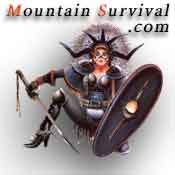

Check Your Gear Before You Go!!!!!
 |
 |
|
Check Your Gear Before You Go!!!!!
|
|
| Welcome To The Deep Freeze Sure, coping with cold is a mental thing, but it also helps if you stand on your sleeping pad while repeating the "3 Ws." Paul Schurke, a.k.a. The Iceman, loves to tell his students, "Cold is an outstanding teacher." Here are some lessons he's learned from his chilly mentor. Before You Go • Introduce yourself to winter travel and camping through short overnight trips. • Plan an itinerary that offers "escape routes." • Test all of your gear at home; when the temperature's at -30<°>F is no time to realize your stove doesn't work. • Check the local weather forecast. On The Trail • Remember the "3 Ws" (wicking, warmth, and wind) of layering. The layer next to your skin should be polypropylene, which wicks away moisture. Next, pull on a fleece layer to trap body-warmed air. Finally, zip on a tightly woven, breathable, windproof layer that lets moisture out but keeps warmth in. In extremely cold conditions, add another warmth layer. • The same "3 Ws" apply to your hands (thin polypropylene gloves, warm mittens, breathable outer shell) and your head (thin wicking hat first, warm hat, hood for wind protection). • Add fat zipper pulls to your gear so you can undo zippers while wearing mittens. • Keep a supply of quick-energy foods, such as hard candy, handy. • Drink plenty of water and sports drinks. Dehydration can lead to headaches and cold extremities. • Bring two pairs of felt liners for your pac boots, one for daytime use and the other for around camp. In Camp • Choose a campsite sheltered from the wind. Because cold air sinks, a hillside campsite will be warmer than one on a valley floor. An eastern exposure will give you direct morning sun. • Change into dry, warm clothes as soon as possible to keep from getting chilled. • Stand on your sleeping pad (though only if it's a closed-cell foam pad) to keep cold from seeping up from below. • Chop, slice, dice, and remove excess packaging from foods before you leave home. This reduces the number of chores that require you to remove your gloves. Keep food preparation simple. • Use insulated cups or cup wraps to keep drinks hot longer. In Bed • Your sleeping bag will absorb several hundred calories' worth of body heat during the first few hours of the night to bring it up to sleeping temperature. So, do jumping jacks or take a hike before bed--anything to raise your core body temperature to start the night warm. • Use two sleeping pads under your sleeping bag. A self-inflating foam mattress together with a closed-cell foam pad makes a warm, comfortable combination. • Sleep on top of your parka and insulated pants. Put your gloves, socks, boot liners, and the next day's clothes inside the sleeping bag. • Wear warm, loose-fitting layers to bed. Always wear a hat. Booties worn with clean, dry socks help keep feet cozy. • Vent your tent. Leave one door partially open at the bottom and a second door or window slightly open at the top to allow cross ventilation and minimize frost buildup. • Slip a hot water bottle inside your bag, but be sure the lid is tight. • Flare open boots as wide as possible so you can slip them on more easily in the morning when they're frozen. • When nature calls, don't hold it. Keeping urine at body temperature uses up energy better spent warming your body. A pee bottle can save you a nippy trip outside of the tent. • Keep some high-energy food handy for midnight snacking. • Be careful not to breathe inside your bag. Humid breath can lead to frost buildup. Adapted from BACKPACKER magazine, December 1997; by Jeff Rennicke. |
|||